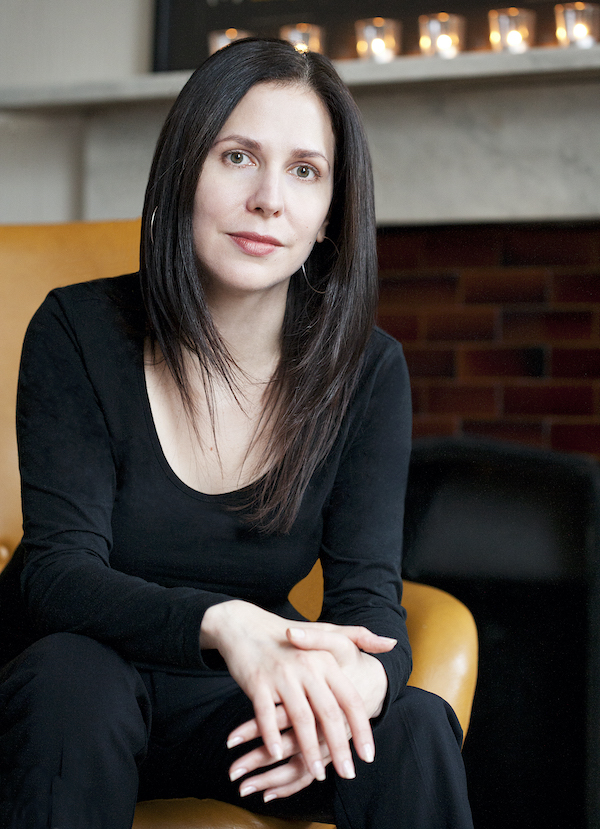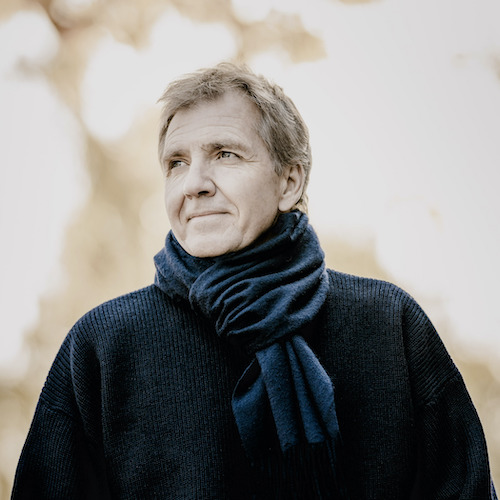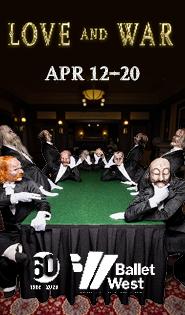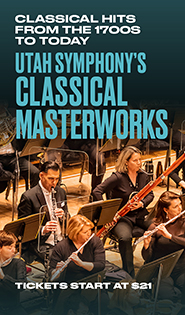Sierra’s avian world premiere to take flight with Utah Symphony

This season the Utah Symphony seems to be encouraging audience members to leave the house and enjoy the great outdoors.
Recent programs included Beethoven’s “Pastoral” symphony (No. 6), Debussy’s Prelude to the Afternoon of a Faun, and The Maze, a new violin concerto by Nathan Lincoln de Cusatis inspired by Canyonlands National Park. The Symphony will even perform Oliver Messiaen’s Utah-inspired From the Canyons to the Stars in its complete form June 2 at an amphitheater near Zion National Park.
Music director Thierry Fischer said an interest in nature was one of the things that attracted him to this season’s composer-in-association Arlene Sierra.The seemingly serendipitous al fresco emphasis culminates this weekend with Fischer and the Utah Symphony giving the world premiere of Sierra’s Bird Symphony.
“This idea of celebrating what’s surrounding us in Utah is very important to me, because it’s such a unique place,” Fischer said in an interview. “Arlene is writing a lot on nature—about birds, about insects—it’s in the titles of her pieces.”
In November, the orchestra played Sierra’s Aquilo, a one-movement piece inspired by the Northeast wind, and last week played her Nature Symphony, with movements devoted to butterflies, a stark landscape, and bees. With unsettling dissonance and a fierce rhythmic drive, Sierra’s pieces display a less romanticized vision of nature than many of the nature-themed pieces in the standard repertoire.
“I’m really interested in this idea of modern pastoral,” said the composer last week. “For older generations, certainly in the Romantic period, it was about nature being perfect, how a human lost in the countryside admires the beauty of nature. Now, our situation is so different.”
“First, we understand these processes and how complex nature is and how brutal nature is, and the Romantics never really thought much about that,” said Sierra. “Also, we’re living with the consequences of the 19th and 20th centuries where we were destroying nature while the artists were going out and swooning over it.
“I’m really interested in the idea of wrestling with this predicament that we’re in where we love nature, we understand it so much better, and we’re losing it all at the same time.”
Bird Symphony is the latest in a series works Sierra has written that incorporate actual bird songs. Previous works include 2014’s Urban Birds, a piece for three pianos, and a series of solo piano pieces titled Birds and Insects, Books 1 and 2, completed in 2007 and 2015, respectively. To research bird songs, she used online databases including the Cornell Lab Database.
Sierra’s Bird Symphony is cast in four movements, each with a different avian inspiration.
The first movement is inspired by the American Warbler species, some of which are native to Utah, said Sierra. “I had this idea of this kind of frenetic, warbling music, but it’s built on the actual birdsongs, and the idea—I have to do things that make me laugh—of turning the orchestra into a gigantic Warbler, making the whole orchestra sound like this little tiny thing but on a massive scale.”
Sierra describes the ensuing section as a “more atmospheric movement and maybe a little bit mournful too.” Sierra wrote this second movement, which reflects the Hermit Thrush, in London in 2020 when the first Covid lockdown was happening. Like the Thrush, she said she felt like a hermit herself. She also felt a kinship with domesticated birds, so she incorporated the songs of captive birds, such as canaries and finches. She also incorporated a few notes from an “unreal bird”: one of the imitated birdsongs from Ravel’s Daphnis et Chloe. “I feel such a kindship from the composers who love birds, and Ravel really is my touchstone,” she said. “The meticulousness and elegance of his writing, and there’s a very profound expression that’s kind of under the surface.”
Like Respighi in his Pines of Rome, the second movement utilizes a recording of a birdsong with which the orchestra interacts. Sierra recalled hearing the Respighi piece after visiting Rome in the 1990s and realizing that a lot of the nature depicted was gone. “I so remember hearing that beautiful nightingale call on the clarinet and knowing that Rome doesn’t sound like that anymore,” she said. “You have to travel hundreds of miles away from Rome to even hear a bird. All the piazzas are parking lots now. That movement from 1925, is a time capsule, and it’s so poignant, and it’s so sad.”
The third movement is a light scherzo exclusively featuring the songs of female birds, which was prompted by Sierra’s discovery that, for a long time, scientists didn’t believe female birds sang at all. “We are living with the legacy of Victorian ornithologists who are all men and didn’t think the female birds sang,” she said. “In our time, there are women ornithologists who are publishing papers saying ‘Hey dudes: The females sing too!’”
Sierra listened to songs of female birds and discovered that, to her ears, they sounded like replies to the songs of the male of their species. “It’s like an answer to the male’s song,” she said. “It’s like a third higher. They complement each other.”
The fourth and final movement is inspired by the Utahraptor, a large, carnivorous, feathered dinosaur whose bones were discovered in Southern Utah, providing a crucial link indicating that birds descended from dinosaurs. Sierra is fascinated by the idea that birds are living dinosaurs and tried to create music highlighting the similarities. “I imagined this kind of menacing birdsong turning into this absolutely terrifying raptor dinosaur idea,” Sierra said. “It’s a sort or primitive, rhythmic, growing sort of terrifying transformation.”
Of course, music incorporating birdsong invites comparisons to Messiaen, who transcribed and quoted birdsong in several of his pieces, including Catalogue d’oiseaux (“Catalogue of birds”), a series of 13 piano pieces, each imitating a different species of French bird.
“The way he presents birdsong is so catalogued, you know ‘Here are the birds, literally,’” she said. “I use them very differently. For me they’re motifs, they’re building blocks. I take bits of the birdsongs and make new pieces.”
Sierra’s music often focuses on the mechanistic processes of nature, which she reflects by layering ostinato passages in interesting, sometimes chaotic patterns. She attributed this textural sensibility to her time as an undergraduate at Oberlin in the early 1990s, where she earned a degree in electronic music composition.
“The idea of creating and then timing different loops was kind of a way into compositional thinking for me,” she said. “I think it’s influenced a lot about how I put pieces together in terms of competing layers of ostinati and rhythmic patterning and things being in sync and out of sync.”
Sierra wrote her first non-electronic pieces at Oberlin, under the guidance of composer Michael Daugherty, who advised her to take his introductory composition class and then spend the summer studying at the Aspen Music Festival. When she returned from Aspen, he looked at her portfolio and advised her to apply to graduate school at Yale. Sierra was surprised that Daugherty thought she was ready. “I had written three pieces with notes, everything else was electronic,” she remembered.
Still, her portfolio was enough to impress Jacob Druckman, who became her teacher at Yale. After completing her master’s degree at Yale and her doctorate at the University of Michigan, Sierra moved to England, where she worked as an instructor at Cambridge before accepting her current position as a professor of composition at Cardiff University in Wales, where she has been since 2004.
Although she doesn’t like to be pigeonholed—no bird pun intended— as a composer, Sierra is comfortable being considered a modernist. She admires the atonal music that grew out of the Second Viennese School more than the neo-Romantic and minimalist music that developed later. “I love chromaticism, and I get a bit a bored with neo-tonal music,” she said. “I think maybe the last great tonal composers for me are Prokofiev and Mahler.”
“What I share with John (Adams) and Steve (Reich) and the minimalists is that I love rhythmic energy; I love music that dances, but I like to subvert the dance,” she said. “I like to put spanners in the works and make the rhythm do things you don’t expect, but I like it to feel inevitable. I’m interested in organic growth that has a right feeling about it, in a visceral way.”
Fischer finds an impressionistic, allusive quality to Sierra’s music.
“What I like about her music is that everything is suggested; it’s not a statement,” Fischer said. “For example: if you see a bird flying, it’s so beautiful, and it creates a kind of emotion. But the bird doesn’t fly to create an emotion. The bird flies because that’s what a bird does.”
“It’s a little bit like that in Arlene’s music, “ adds Fischer. “She’s not writing the Bird Symphony to make people cry. She writes because it’s her way to be inspired by nature and by insects and all that. And then it creates beauty, but she’s not writing to create beauty. This aspect of both the suggestive and what’s behind it is, to me as a French impressionist conductor, absolutely thrilling and super motivating.”
Thierry Fischer conducts the world premiere of Arlene Sierra’s Bird Symphony 7:30 p.m. Friday and Saturday at Abravanel Hall. The program also includes Haydn’s Symphony No. 11, Elgar’s In the South, and Nielsen’s Clarinet Concerto with soloist Anthony McGill. utahsymphony.org


